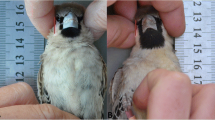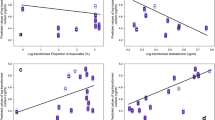Summary
-
1.
The social system and behavior of a population of Tamias striatus were studied from October 1973 to November 1976 on a 5-ha woodlot in southeastern Ohio. The basic social unit is the solitary individual occupying a single burrow system, but a more complex social unit consisting of mother and litter persists briefly until emergence and dispersal of the litter from the natal burrow site. Burrow systems are distributed in a regular pattern and are surrounded by nonoverlapping core areas which are defended throughout the year by adults and seldom by subadults or juveniles. Defense of home sites has evolved as a mechanism to insure individuals an adequate share of a seasonal food supply. Two other spacing mechanisms occur in the annual cycle: defense of individual distances and relative dominance hierarchies. Rare instances of aggressive behavior in juveniles and subadults are examples of defense of individual distance. Relative dominance hierarchies form among adult males participating in a mating bout in core areas of estrous females. Brief pairing and multiple mating occur during a single mating bout.
-
2.
Time budgets vary with sex and age class and also due to temporal, spatial, and social factors. The adaptiveness of differential time budgets resulting from the effects of these factors is discussed. Individual behavioral profiles are related to successful defense of home sites and reproductive fitness. Unaggressive adults are never or rarely territorial and do not mate, but extreme aggressiveness may be disadvantageous under certain circumstances. The ontogeny of aggressive behavior is discussed and factors selecting against precocious aggressiveness and sexual behavior are suggested.
-
3.
The social system and behavior are major determinants of population dynamics and spatial distribution. Territoriality acts to regulate population density and partially determines the pattern of dispersion. Dispersing juveniles are forced into vacant areas, marginal habitats, or distant areas from birth sites by aggressive behavior in residents. Extrinsic factors which regulate density and determine spatial distribution include food resources and predation. The social system and behavior typifies that of a mammalian species adapted to a dispersed, solitary way of life.
Similar content being viewed by others
References
Altmann, J.: Observational study of behavior: sampling methods. Behaviour 49, 227–267 (1974)
Armitage, K.B.: Social behaviour of a colony of the yellow-bellied marmot (Marmota flaviventris). Anim. Behav, 10, 319–331 (1962)
Armitage, K.B.: Scent-marking by yellow-bellied marmots. J. Mammal. 57, 583–584 (1976)
Barash, D.P.: The evolution of marmot societies: a general theory. Science 185, 415–420 (1974)
Barnett, S.A., Evans, C.S.: Questions on the social dynamics of rodents. Symp. Zool. Soc. London 14, 233–248 (1965)
Betts, B.J.: Behaviour in a population of Columbian ground squirrels, Spermophilus columbianus columbianus. Anim. Behav. 24, 652–680 (1976)
Brand, L.R.: The vocal repertoire of chipmunks (Genus Eutamias) in California. Anim. Behav. 24, 319–335 (1976)
Brenner, F.J.: Effect of previous photoperiod conditions and visual stimulation on food storage and hibernation in the eastern chipmunk (Tamias striatus). Amer. Midl. Nat. 93, 227–234 (1975)
Brown, J.H.: Mechanisms of competitive exclusion between two species of chipmunks. Ecology 52, 305–311 (1971)
Brown, J.L.: The evolution of behavior. New York: Norton 1975
Carl, E.A.: Population control in arctic ground squirrels. Ecology 52, 395–413 (1971)
Chitty, D.: The natural selection of self-regulatory behaviour in animal populations. Proc. Ecol. Soc. Australia 2, 51–78 (1967)
Cooley, W.W., Lohnes, P.R.: Multivariate data analysis. New York: Wiley 1971
Cox, G.W.: Laboratory manual of general ecology. Dubuque, Iowa: Brown 1976
Crook, J.H.: Social organization and the environment: aspects of contemporary social ethology. Anim. Behav. 18, 197–209 (1970)
Crook, J.H., Ellis, J.E., Goss-Custard, J.D.: Mammalian social systems: structure and function. Anim. Behav. 24, 261–274 (1976)
Davis, D.E., Christian, J.J., Bronson, F.: Effect of exploitation on birth, mortality, and movement rates in a woodchuck population. J. Wildl. Manage 28, 1–9 (1964)
Dobroruka, L.J.: Scent marking and courtship in Siberian chipmunks, Tamias sibiricus lineatus (Siebold, 1824), with notes on the taxonomic relations of chipmunks (Mammalia). Věstn. čs. spol. zool. 36, 12–16 (1972)
Dunford, C.: Behavioral aspects of spatial distribution in the chipmunk, Tamias striatus. Behaviour 36, 215–231 (1970)
Dunford, C.: Summer activity of eastern chipmunks. J. Mammal. 53, 176–180 (1972)
Eisenberg, J.F.: The social organizations of mammals. Handb. Zool. 10, 1–92 (1966)
Eisenberg, J.F.: A comparative study in rodent ethology with emphasis on evolution of social behavior. Proc. U.S. Nat. Mus. 122, 1–51 (1967)
Eisenberg, J.F., Kleiman, D.G.: Olfactory communication in mammals. Ann. Rev. Ecol. Syst. 3, 1–32 (1972)
Elliot, A.L.: Social behavior and foraging ecology of the eastern chipmunk (Tamias striatus) in the Adirondack Mountains of New York. Smithsonian Contrib. Zool. (in press) (1978)
Etkin, W.: Social behavior from fish to man. Chicago: Univ. Chicago Press 1971
Ewer, R.F.: Ethology of mammals. London: Logo Press 1968
Farentinos, R.C.: Social communication in the tassel-eared squirrel (Sciurus aberti): a descriptive analysis. Z. Tierpsychol. 34, 441–458 (1974)
Ferron, J.: Solitary play of the red squirrel (Tamiasciurus hudsonicus). Canad. J. Zool. 53, 1495–1499 (1975)
Finn, J.D.: Univariate and multivariate analysis of variance, covariance, and regression: a fortran IV program. Buffalo: State Univ. New York 1968
Forbes, R.B.: Studies of the biology of Minnesotan chipmunks. Amer. Midl. Nat. 76, 290–308 (1966)
Hall, E.R., Kelson, R.: The mammals of North America. New York: Ronald Press 1959
Heller, C.H.: Altitudinal zonation of chipmunks (Eutamias): interspecific aggression. Ecology 52, 312–319 (1971)
Horn, H.S.: The adaptive significance of colonial nesting of the Brewer's Blackbird (Euphagus cyanocephalus). Ecology 49, 682–694 (1968)
Ickes, R.A.: Agonistic behavior and the use of space in the eastern chipmunk, Tamias striatus. PhD thesis, Univ. Pittsburgh (1974)
King, J.A.: Social behavior, social organization and population dynamics in a black-tailed prairie dog town in the Black Hills of South Dakota. Univ. Mich. Lab. Vert. Biol. Contrib. 67, 1–123 (1955)
King, J.A.: The ecology of aggressive behavior. Ann. Rev. Ecol. Syst. 4, 117–138 (1973)
Kivett, V.K., Murie, J.O., Steiner, A.L.: A comparative study of scent-gland location and related behavior in some northwestern nearctic ground squirrel species (Sciuridae): an evolutionary approach. Canad. J. Zool. 54, 1294–1306 (1976)
Krebs, C.J.: Ecology. New York: Harper & Row 1973
Lill, A.: Social organization and space utilization in the lek-forming white-bearded manakin, M. manacus trinitatis Hartert. Z. Tierpsychol. 36, 513–530 (1974)
Linduska, J.P.: Ecology and land use relationships of small mammals on a Michigan farm, Vol. 128 (University Microfilms). Ann Arbor, Michigan: Michigan State College Publ. 1949
Lynch, G.R.: Seasonal changes in thermogenesis, organ weights, and food consumption in the whitefooted mouse, Peromyscus leucopus. Oecologia 13, 363–376 (1973)
Panuska, J.A.: Weight patterns and hibernation in Tamias striatus. J. Mammal. 40, 554–566 (1959)
Quay, W.B.: Comparative survey of the sebaceous and sudoriferous glands of the oral lips and angle in rodents. J. Mammal. 46, 23–37 (1965)
Rummel, R.J.: Applied factor analysis, Evanston: Northwestern University Press 1970
Sheppard, D.H.: Competition between two chipmunk species (Eutamias). Ecology 52, 320–329 (1971)
Skirrow, M.H., Rysan, M.: Observations on the social behaviour of the Chinese hamster, Cricetulus griseus. Canad. J. Zool. 54, 361–368 (1976)
Slade, N.A., Balph, D.F.: Population ecology of Uinta ground squirrels. Ecology 55, 989–1003 (1974)
Smith, C.C.: The adaptive nature of social organization in the genus of tree squirrels Tamiasciurus. Ecol. Monogr. 38, 31–63 (1968)
Smith, D.A., Smith, L.C.: Oestrus, copulation, and related aspects of reproduction in female eastern chipmunks, Tamias striatus (Rodentia: Sciuridae). Canad. J. Zool. 53, 756–767 (1975)
Sokal, R.R., Rohlf, F.J.: Biometry. San Francisco: W.H. Freeman 1969
Steiner, A.L.: Self-and allo-grooming in some ground squirrels (Sciuridae), a descriptive study. Canad. J. Zool. 51, 151–161 (1973)
Steiner, A.L.: Body-rubbing, marking, and other scent-related behavior in some ground squirrels (Sciuridae). a descriptive study. Canad. J. Zool. 52, 889–906 (1974)
Stokes, A.W., Cox, L.M.: Aggressive man and aggressive beast. BioSci. 20, 1092–1095 (1970)
Svendsen, G.E.: Behavioral and environmental factors in the spatial distribution and population dynamics of a yellow-bellied marmot population. Ecology 55, 760–771 (1974)
Svendsen, G.E., Yahner, R.H.: Habitat preference and utilization by the eastern chipmunk (Tamias striatus). Kirklandia (in press) (1978)
Travis, S.E., Armitage, K.B.: Some quantitative aspects of the behavior of marmots. Kansas Acad. Trans. 75, 308–321 (1972)
Turner, B.N., Iverson, S.L.: The annual cycle of aggression in male Microtus pennsylvanicus, and its relation to population parameters. Ecology 54, 967–981 (1973)
West Eberhard, M.J.: The evolution of social behavior by kin selection. Quart. Rev. Biol. 50, 1–33 (1975)
Wolfe, J.L.: Agonistic behavior and dominance relationships of the eastern chipmunk, Tamias striatus. Amer. Midl. Nat. 76, 190–200 (1966)
Wolfe, J.L.: Observations on alertness and exploratory behavior in the eastern chipmunk. Amer. Midl. Nat. 81, 249–253 (1969)
Wrazen, J.A.: Feeding ecology of a population of eastern chipmunks (Tamias striatus) in Southeast Ohio. MS thesis, Ohio Univ., Athens (1976)
Yahner, R.H.: The adaptive significance of scatter hoarding in the eastern chipmunk. Ohio J. Sci. 75, 176–177 (1975)
Yahner, R.H.: Activity lull of Tamias striatus during the summer in Southeast Ohio. Ohio J. Sci. 77, 143–145 (1977a)
Yahner, R.H.: Behavior and social system in the eastern chipmunk, Tamias striatus. PhD thesis. Ohio Univ., Athens, Ohio (1977b)
Yahner, R.H.: Weight gain in post-emergent juvenile Tamias striatus. J. Mammal. 59, 196–197 (1978a)
Yahner, R.H.: Burrow system and home range use by chipmunk, Tamias striatus: ecological and behavioral considerations. J. Mammal. (in press) (1978b)
Yahner, R.H., Svendsen, G.E.: The effects of climate on the circannual rhythm of the eastern chipmunk. J. Mammal. 59, 109–117 (1978)
Yerger, R.W.: Life history notes in the eastern chipmunk, Tamias striatus lysteri (Richardson), in central New York. Amer. Midl. Nat. 53, 312–322 (1955)
Author information
Authors and Affiliations
Rights and permissions
About this article
Cite this article
Yahner, R.H. The adaptive nature of the social system and behavior in the eastern chipmunk, Tamias striatus . Behav Ecol Sociobiol 3, 397–427 (1978). https://doi.org/10.1007/BF00303202
Received:
Issue Date:
DOI: https://doi.org/10.1007/BF00303202




